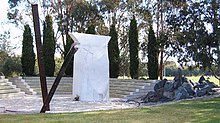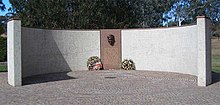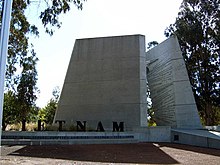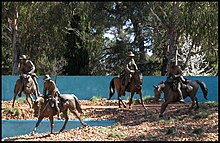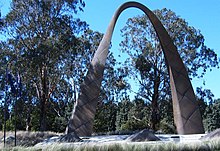ANZAC parade
| Australian War Memorial | ||
|---|---|---|
| Limestone Avenue (roundabout) Fairbairn Avenue | ||
| Hellenic monument | ANZAC parade |
Ataturk Monument |
| free location | free location | |
| Army memorial | Navy memorial | |
| Korean War Memorial | Memorial to the Army Nurses |
|
| Vietnam monument | Air Force Memorial | |
| Desert rider memorial | Tobruk monument | |
| Boer War memorial | Peacekeepers Memorial | |
| Australia monument | New Zealand Monument | |
| Constitution Avenue | ||
|
ANZAC Park West (office building) |
ANZAC Park East (office building) |
|
| Parkes Way (Fountain) Parkes Way | ||
| free location | lakeside | Emergency services monument |
| Lake Burley Griffin | ||
The ANZAC Parade is a prestigious street in the Australian capital of Canberra . It is named after the Australian and New Zealand Army Corps (ANZAC), which was formed from Australian and New Zealand soldiers and fought in Europe during the First World War . The street was officially inaugurated on April 25, 1965 by Prime Minister Robert Menzies , on the 50th anniversary of the Battle of Gallipoli .
description
The road begins in the south at Lake Burley Griffin and leads to the Australian War Memorial in the north. It lies on the main axis between Parliament House and Mount Ainslie and divides Constitution Avenue into two halves (this in turn forms one side of the Parliamentary Triangle ).
The ANZAC Parade is lined with numerous war memorials and eucalyptus trees on both sides . Between the two three-lane lanes (each one-way traffic) there is a wide parade ground made of reddish granular rock, flanked by borders with flat lifting bushes from New Zealand. On ANZAC Day (April 25) and other ceremonial occasions, parades of various branches of the armed forces and veterans take place on the ANZAC Parade and adjacent streets.
At the intersection of ANZAC Parade and Constitution Avenue is the Anglican St John the Baptist Church . The church was consecrated by the Bishop of Australia on March 12, 1845, 66 years before Canberra was chosen as the future capital city. It almost seems as if the church had been aligned precisely to fit into the strictly geometric street grid planned by Walter Burley Griffin seven decades later .
On ANZAC Day 2006, the Ministry of Environment and Heritage Protection put the ANZAC Parade and the Australian War Memorial under monument protection.
Monuments
Hellenic monument
The Hellenic Memorial (English Australian Hellenic Memorial ) commemorates the Australian Army , which had to retreat in Greece in April 1941 from advancing German troops and was defeated a few weeks later in the airborne battle for Crete . At that time, over 5,000 Australian soldiers were taken prisoners. The members of the Royal Australian Air Force , the Royal Australian Navy and the Merchant Navy who were involved in this conflict are also remembered.
On May 21, 1988, the Australian Prime Minister Bob Hawke and the Greek Deputy Prime Minister Ioannis Charalambopoulos inaugurated the monument. It symbolizes a Doric column in an amphitheater and is surrounded by black pines from Cyprus . The column, adorned with a cross from the Greek Orthodox Church , stands on a mosaic depicting the coastline of Greece and the Aegean Islands . The damaged steel fragments represent the futility and destruction of war. Behind the main monument, on April 28, 1991, the Deputy Prime Ministers of Australia and Greece, Paul Keating and Tzannis Tzannetakis , planted a tree commemorating the battles on mainland Greece and Crete 50 years ago.
Ataturk Monument
Mustafa Kemal Ataturk commanded the 19th Ottoman infantry division that resisted the ANZAC on the Gallipoli peninsula during the First World War in 1915 . At that time, 8,700 Australians and 2,700 New Zealanders died. Eight years later he became the first president of Turkey . In 1985, seventy years after the battle, the Turkish government renamed the landing site for Australian and New Zealand soldiers "Anzac Bay". In return, the Australian government had the Ataturk Memorial (English Kemal Ataturk Memorial ) built.
The monument, lined with Aleppo pines from the Gallipoli peninsula, consists of a semicircular wall on a circular surface. The wall represents the crescent moon on the flag of Turkey . In the center of the monument is a time capsule with soil from the Gallipoli battlefields. The bronze figure in the middle of the wall represents Ataturk. The inscription underneath is Ataturk's message to the opposing soldier's mothers, intended to give them consolation. It is the only monument on the road dedicated to an opposing military leader.
The English text of the inscription reads: “Those heroes that shed their blood and lost their lives… You are now lying in the soil of a friendly country. Therefore rest in peace. There is no difference between the Johnnies and the Mehmets to us where they lie side by side here in this country of ours… You, the mothers who sent their sons from faraway countries, wipe away your tears; your sons are now lying in our bosom and are in peace. After having lost their lives on this land they have become our sons as well. “Kemal Ataturk
The German translation: “These heroes who shed their blood and gave their lives ... you are now in the earth of a friendly land. Therefore rest in peace. Because for us there is no difference between the Johnnies and the Mehmets, where they lie side by side in this our country ... You, the mothers who sent their sons from far-flung lands, wipe away your tears. Your sons are now on our bosom and are at peace. Having lost their life in this country also made them our sons. ”Kemal Ataturk
Army memorial
The Army Memorial, inaugurated on November 1, 1989 by Governor General Bill Hayden , commemorates the soldiers of the Australian Army who have been involved in numerous wars alongside other Commonwealth countries since the Boer War .
The two central figures represent two Australian soldiers looking east towards the rising sun. They symbolize support and camaraderie. They wear the floppy hats with the badge of the rising sun that are typical for Australia. The figures stand on a raised podium with a radial pattern based on the army's markings. Seven pillars represent seven major conflicts the Australian Army participated in during the 20th century. These are surrounded by water, symbolizing the long sea voyages that were necessary in each case.
Navy memorial
The Royal Australian Navy Memorial is dedicated to the Royal Australian Navy (RAN) . It was officially inaugurated by Queen Elizabeth II on March 3, 1986 , 75 years after the founding of the RAN. It honors the Australian seafarers who have served their country.
The memorial is also known as the Sailors and Ships - Interaction and Independence. Various bronze figures depict the daily activities of seafarers. Geometric shapes such as the anchor chain represent the elements of a ship. Waterfalls underline the dynamism of the monument (during the drought in 2005, the monuments along the ANZAC parade were expressly excluded from water-saving measures).
Korean War Memorial
The Korean War from 1950 to 1953 involved 17,000 Australian soldiers under the command of the United Nations . The Korean War Memorial (English National Korean War Memorial ) is dedicated to them. The foundation stone was laid by the South Korean President Kim Dae-jung and the Australian Prime Minister John Howard on September 17, 1999. The latter officially inaugurated the memorial on April 18, 2000, together with Governor General William Patrick Deane .
A sidewalk leads into the half-enclosed center of the monument. It consists of a rock from one of the battlefields with the words "Peace and Independence" carved into it in Korean . In the surrounding wall made of stainless steel pictures, maps and texts are engraved, which tell the story of the Australian soldiers in Korea. In the foreground is an obelisk that honors those who died who were buried in unknown places. The monument is surrounded by soldiers' figures and stainless steel bars.
Memorial to the Army Nurses
The Australian Service Nurses National Memorial honors nurses who have served in the Royal Australian Navy , Australian Army , Royal Australian Air Force, and other divisions of the Australian Defense Force . Governor General William Patrick Deane inaugurated this monument on October 2, 1999.
The monument consists of two undulating glass walls. The words “beyond all praise” are engraved on the front wall. The inner wall is decorated with images and text in the form of a timeline depicting the history and contribution of the army nurses. Next to the monument there is a quiet zone surrounded by rosemary bushes with a fountain.
Vietnam monument
From 1962 to 1971, a total of 50,000 members of the Australian Army, the Royal Australian Navy and the Royal Australian Air Force served in the Vietnam War , due to the ANZUS agreement with the USA and New Zealand. The Australian Vietnam Forces National Memorial was inaugurated on October 3, 1992 by General Thomas Daly.
Three concrete steles protruding from a shallow moat form the center and enclose an area of reflection, in the middle of which there is a stone block. On the right wall are 33 inscriptions with quotations from important military and political events. Engraved on the back wall are photos of Australian soldiers waiting for air transport to the base in Nui Dat after the end of "Operation Ulmarrah". The monument is surrounded by six benches dedicated to the six soldiers who have been lost to this day.
Air Force Memorial
The Royal Australian Air Force Memorial is dedicated to the Royal Australian Air Force (RAAF) founded on March 31, 1923 . Fifty years later it was inaugurated by Philip, Duke of Edinburgh . On November 1, 2002, after a redesign and rededication, the memorial was reopened in the presence of Governor General Peter Hollingworth , Prime Minister John Howard and Air Marshal Angus Houston .
Three upturned wings stand for endurance, strength and courage. A bronze sculpture embodies the effort of man to overcome the elements. The RAAF's motto is engraved in the base of the sculpture: Per ardua ad astra (“By overcoming difficulties to the stars”). This part of the monument dates from 1973. Three black granite walls were added in 2002. The front wall is dedicated to the more than 14,000 fallen RAAF members, on the back of the two shorter walls the RAAF Battle Honors are listed.
Desert rider memorial
The monument of mounted desert Corps (Engl. Desert Mounted Corps Memorial ) is a copy of an earlier statue, which the then Prime Minister Billy Hughes in the November 23, 1932 Port Said had revealed. During the Suez Crisis in 1956, the statue was irreparably damaged. The remains were brought to Australia and made into a new statue. Prime Minister John Gorton unveiled them on April 19, 1968.
The memorial is dedicated to the desert riders of the Australian Army who fought in Egypt , Palestine and Syria from 1916 to 1918 during the First World War . Two cavalrymen are shown in the uniform of that time, with the slouch hat typical of Australia. The horse on the right has been injured or shot and the rider falls to the ground; the rider on the left helps his comrade.
Tobruk monument
On April 13, 1983, Governor General Ninian Stephen unveiled the " Rats of Tobruk Memorial ". This honorary designation was given to those Australian soldiers who defended the Libyan city of Tobruk against German and Italian troops from April to October 1941 (see Siege of Tobruk ).
The original of the monument was created during the siege at the Tobruk military cemetery, but was later destroyed. The original memorial stone is integrated in the copy, the only remaining part (and at times a step in front of the Tobruk post office). The monument has the shape of an obelisk . Surrounding walls symbolize the lines of defense. In 1984 an Eternal Flame was added in a bronze bowl.
Boer War memorial
The National Boer War Memorial commemorates the 23,000 mounted soldiers from the then six British colonies in Australia who took part in the Second Boer War in South Africa from October 1899 to May 1902 . It was inaugurated on May 31, 2017 by Governor General Peter Cosgrove .
It depicts four Australian soldiers on horses riding through the trees of the ANZAC parade. The meaning is that they represent a four-man squad, a standard formation for combat and patrol. When they went into battle, three men dismounted while the fourth took the horses for cover. Letters from veteran Frederick Harper Booth lie at the feet of the horses.
Peacekeepers Memorial
The peacekeepers Memorial (Engl. Australian Peacekeeping Memorial ) remembers the services of more than 80,000 soldiers, policemen and civilians since 1947 for the peacekeepers of the United Nations are in use. Governor General Peter Cosgrove inaugurated it on October 14, 2017.
The memorial consists of two main elements. The first is a glowing passage of light that creates a powerful passage to the monument. The passage is located between two massive monoliths that are slightly raised from the ground in a stone courtyard. The path between the two polished cubes shines with an intense golden light. This light is a reminder of the role played by the Australian peacekeepers in helping local people.
Australia New Zealand Monument
The Australia-New Zealand Memorial was unveiled on April 24, 2001 by the Prime Ministers of New Zealand and Australia, Helen Clark and John Howard. The bronze monument is in two parts and stands on either side of the intersection of ANZAC Parade and Constitution Avenue. It is a reminder of the close friendly relations between neighboring states. Two handles of a flat basket are shown; both are eleven meters high and symbolize an important part of New Zealand culture. The design of the handles is reminiscent of a Māori proverb : Mau tena kiwai o te kete, maku tenei (“You hold one handle of the basket, I hold the other”).
Emergency services monument
The National Emergency Services Memorial is located on the north bank of Lake Burley Griffin . It honors the members of the police, fire brigade, emergency services and similar civil organizations who lost their lives while working for the safety of citizens. Prime Minister John Howard unveiled the memorial on July 12, 2004. A feature of the memorial wall is a three-dimensional frieze that collects a series of images that reflect the diversity of the emergency services and some of their experiences.
See also
Web links
Individual evidence
- ↑ ANZAC parade. Visit Canberra, accessed February 27, 2020 .
- ↑ ANZAC parade. National Capital Authority , accessed February 27, 2020 .
- ↑ Baedeker Travel Guide Australia . Karl Baedeker, Freiburg im Breisgau 2015, ISBN 978-3-8297-9470-1 , p. 188 .
- ^ National Heritage Places - Australian War Memorial and the Memorial Parade. Department of Agriculture, Water and the Environment, April 25, 2006, accessed February 27, 2020 .
- ↑ a b Australian Hellenic Memorial. Monument Australia, accessed February 27, 2020 .
- ↑ a b Mustafa Kemal Ataturk. Monument Australia, accessed February 27, 2020 .
- ↑ a b Ataturk (Mustafa Kemal). Australian War Memorial , accessed February 27, 2020 .
- ↑ a b Australian Army National Memorial. Monument Australia, accessed February 27, 2020 .
- ^ A b Australian National Korean War Memorial. Monument Australia, accessed February 27, 2020 .
- ^ A b Australian Service Nurses National Memorial. Monument Australia, accessed February 27, 2020 .
- ^ A b Australian Vietnam Forces National Memorial. Monument Australia, accessed February 27, 2020 .
- ^ A b Royal Australian Air Force Memorial. Monument Australia, accessed February 27, 2020 .
- ^ A b Royal Australian Air Force Memorial. Monument Australia, accessed February 27, 2020 .
- ↑ a b Rats of Tobruk. Monument Australia, accessed February 27, 2020 .
- ↑ a b National Boer War Memorial. Monument Australia, accessed February 27, 2020 .
- ^ A b Australian Peacekeeping Memorial. Monument Australia, accessed February 27, 2020 .
- ^ New Zealand Memorial. Monument Australia, accessed February 27, 2020 .
- ^ National Emergency Services Memorial. Monument Australia, accessed February 27, 2020 .
Coordinates: 35 ° 17 ′ 11 ″ S , 149 ° 8 ′ 38 ″ E

